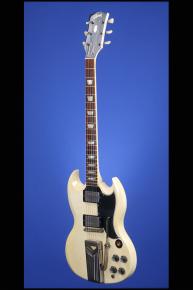A Very Fine, Very Early, Totally Original "Polaris White" SG Standard
This forty-two-year-old 13-inch-wide "Polaris White" SG Standard weighs just 7.50 lbs. and has a nice, fat nut width of just over 1 11/16 inches and a standard Gibson scale length of 24 3/4 inches. Solid Honduras mahogany body, one-piece mahogany neck, and rosewood fretboard with 22 medium jumbo frets and inlaid pearl trapezoid position markers. Headstock with inlaid pearl "Gibson" logo and pearl crown inlay. Four-digit serial number ("6238") stamped indiscernibly on the back of the headstock. Black plastic truss-rod cover with "Les Paul" engraved in white. Individual single-line Kluson Deluxe tuners with tulip-shaped single-ring Keystone plastic buttons. Two original Gibson PAF humbucker pickups with outputs of 7.76k and 7.83k. Each pickup has a black label ("Patent Applied For") on the underside. Original "MR 491" and "MR 490" black pickup rings. With the slightly larger four-layer (black/white/black/white) plastic pickguard almost touching the toggle switch plastic ring, as found on only the very earliest SG/LPs. Four controls (two volume, two tone) plus three-way selector switch, all on lower treble bout. The potentiometers are stamped "134 6027" (Centralab July 1960). Black plastic bell-shaped knobs with metal tops. ABR-1 Tune-O-Matic non-retainer bridge with metal saddles and Gibson sideways Vibrola tailpiece. This super rare and very early example is one of a very few that were finished in Polaris White, assumedly to match the three pick-up "Custom" version, which had gold-plated hardware as opposed to the usual nickel-plated hardware used on "Standards." The size of the pickguard is a more mundane detail, but the earliest SG/LP have a slightly larger guard almost touching the toggle switch plastic ring" (A.R. Duchossoir, Gibson Electrics -- The Classic Years, pp. 209). Apart from a couple of very tiny surface chips and some minimal checking, this wonderful guitar is as near fine as one could ever wish for. Housed in the original Gibson Deluxe brown hardshell case with purple plush lining (9.25).
"Considering all the Les Paul models as a whole, sales declined in 1960 after a peak in 1959...[and] by 1961 Gibson had decided on a complete re-design of the line in an effort to reactivate this faltering model. The company had started a $400,000 expansion of the factory in Kalamazoo during 1960 which more than doubled the size of the plant by the time it was completed in 1961...One of the first series of new models to benefit from the company's newly expanded production facilities was the completely revised line of Les Paul models. Gibson redesigned the Junior, Standard and Custom models, adopting a new, distinctly modern, sculpted double-cutaway design. The 'Les Paul' name was still used at first, but during 1963 Gibson began to call these new models the SG Junior, the SG Standard and the SG Custom...The transition models -- those produced between 1961 and 1963 -- had the new SG design but the old Les Paul names, and these are now known to collectors and players as SG/Les Paul models...SG-style solidbodies have attracted a number of players over the years, including John Cipollina, Eric Clapton, Tony Iommi, Robbie Krieger, Tony McPhee, Pete Townshend, Angus Young and Frank Zappa" (Tony Bacon, Electric Guitars: The Illustrated Encyclopedia, pp. 134-136).
"The restyled LP Standard pioneered the ultra-thin SG body-style which was gradually fitted to most Gibson solid bodies during the early 60s, hence the commonly accepted SG/Les Paul Std moniker. The earliest samples were built in the latter part of 1960 and therefore display inked-on serial numbers on the back of the headstock…No less than four different vibrato tailpieces can be found on the SG/LP Standard. The original 'sideways' Vibrola with a mechanism cast in light alloy was phased out in early 1963 and is primarily associated with 1960-62 models. Before 1963, however, the model was also available with either a short Bigsby unit or Gibson's short Vibrola…Another interesting feature is the evolution of the neck heel between 1960 and 1963. The earliest SG/LP have a highly smoothed-out heel which evolved into a more squared-off configuration with a small ridge in the course of 1961. Subsequently, the neck heel became more prominent and on 1963 models it features a semi-oval plateau. The size of the pickguard is a more mundane detail, but the earliest SG/LP have a slightly larger guard almost touching the toggle switch plastic ring" (A.R. Duchossoir, Gibson Electrics -- The Classic Years, pp. 209).
Translate:









